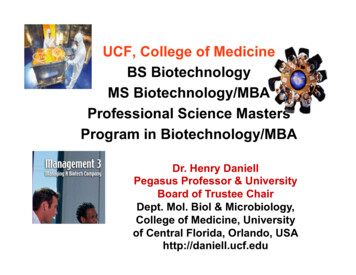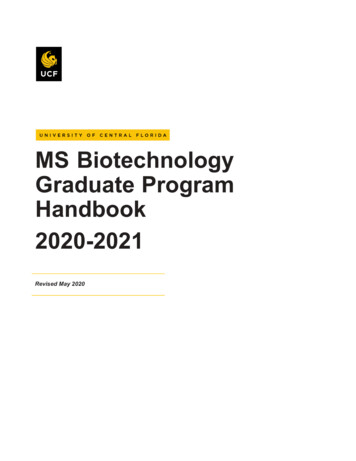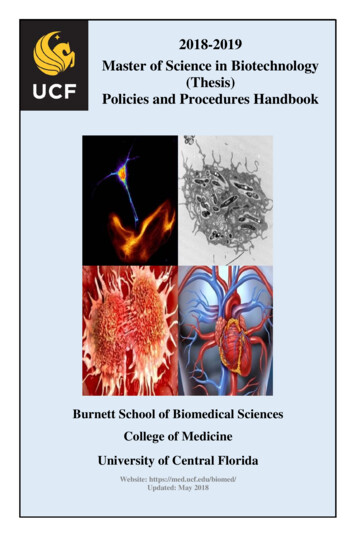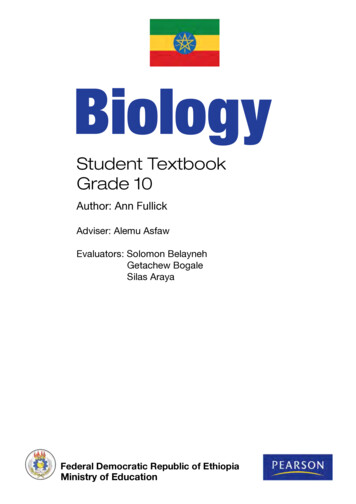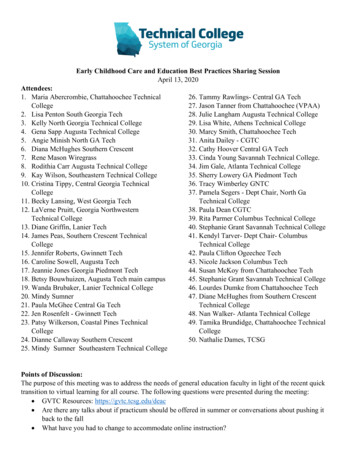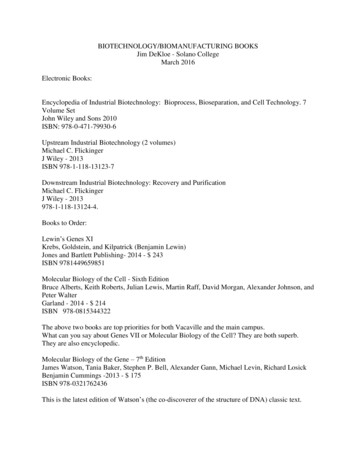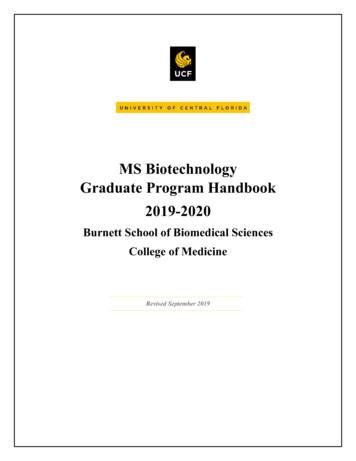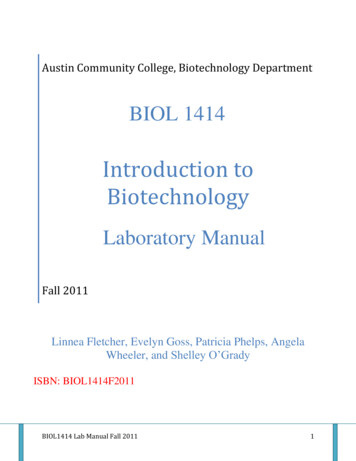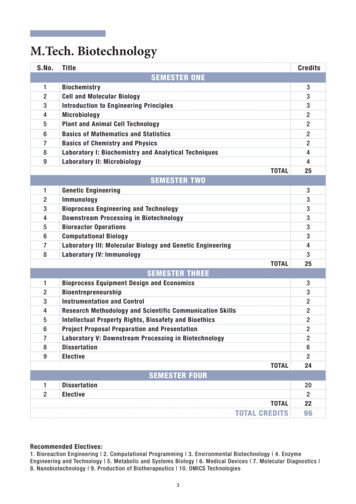
Transcription
M.Tech. BiotechnologyS.No.TitleCreditsSEMESTER ONE12345BiochemistryCell and Molecular BiologyIntroduction to Engineering PrinciplesMicrobiologyPlant and Animal Cell Technology333226789Basics of Mathematics and StatisticsBasics of Chemistry and PhysicsLaboratory I: Biochemistry and Analytical TechniquesLaboratory II: 6224TOTAL20222TOTAL CREDITS96SEMESTER TWO12345678Genetic EngineeringImmunologyBioprocess Engineering and TechnologyDownstream Processing in BiotechnologyBioreactor OperationsComputational BiologyLaboratory III: Molecular Biology and Genetic EngineeringLaboratory IV: ImmunologySEMESTER THREE123456789Bioprocess Equipment Design and EconomicsBioentrepreneurshipInstrumentation and ControlResearch Methodology and Scientific Communication SkillsIntellectual Property Rights, Biosafety and BioethicsProject Proposal Preparation and PresentationLaboratory V: Downstream Processing in BiotechnologyDissertationElectiveSEMESTER FOUR12DissertationElectiveRecommended Electives:1. Bioreaction Engineering 2. Computational Programming 3. Environmental Biotechnology 4. EnzymeEngineering and Technology 5. Metabolic and Systems Biology 6. Medical Devices 7. Molecular Diagnostics 8. Nanobiotechnology 9. Production of Biotherapeutics 10. OMICS Technologies3
Semester OneBiochemistryCredits3Unit IProtein structure7 lecturesUnit IIEnzyme kinetics6 lecturesUnit IIIGlycobiology2 lecturesUnit IVStructure andfunctions of DNA,RNA and Lipids3 lecturesUnit VBio-energetics8 lecturesCourse ObjectivesThe objectives of this course are to buildupon undergraduate level knowledgeof biochemical principles with specificemphasis on different metabolic pathways.The course shall make the students awareof various disease pathologies within thecontext of each topic.Student Learning OutcomesOn completion of this course,students should be able to: Gain fundamental knowledgein biochemistry; Understand the molecularbasis of various pathologicalconditions from the perspectiveof biochemical reactions.Chemical basis of life: Miller-Urey experiment, abiotic formation of amino acidoligomers, composition of living matter; Water – properties of water, essential role ofwater for life on earth pH, buffer, maintenance of blood pH and pH of gastric juice,pH optima of different enzymes (pepsin, trypsin and alkaline phosphatase), ionizationand hydrophobicity, emergent properties of biomolecules in water, biomolecularhierarchy, macromolecules, molecular assemblies; Structure-function relationships:amino acids – structure and functional group properties, peptides and covalent structureof proteins, elucidation of primary and higher order structures, Ramachandran plot,evolution of protein structure, protein degradation and introduction to molecularpathways controlling protein degradation, structure-function relationships in modelproteins like ribonuclease A, myoglobin, hemoglobin, chymotrypsin etc.; basicprinciples of protein purification; tools to characterize expressed proteins; Proteinfolding: Anfinsen’s Dogma, Levinthal paradox, cooperativity in protein folding, freeenergy landscape of protein folding and pathways of protein folding, molten globulestate, chaperons, diseases associated with protein folding, introduction to moleculardynamic simulation.Enzyme catalysis – general principles of catalysis; quantitation of enzyme activity andefficiency; enzyme characterization and Michaelis-Menten kinetics; relevance of enzymesin metabolic regulation, activation, inhibition and covalent modification; single substrateenzymes; concept of catalytic antibodies; catalytic strategies with specific examples ofproteases, carbonic anhydrases, restriction enzymes and nucleoside monophosphatekinase; regulatory strategies with specific example of hemoglobin; isozymes; role ofcovalent modification in enzymatic activity; zymogens.Sugars-mono, di, and polysaccharides with specific reference to glycogen, amyloseand cellulose, glycosylation of other biomolecules-glycoproteins and glycolipids;lipids- structure and properties of important members of storage and membranelipids; lipoproteins.Self-assembly of lipids, micelle, biomembrane organization - sidedness and function;membrane bound proteins - structure, properties and function; transport phenomena;nucleosides, nucleotides, nucleic acids - structure, a historical perspective leading up tothe proposition of DNA double helical structure; difference in RNA and DNA structureand their importance in evolution of DNA as the genetic material.Bioenergetics-basic principles; equilibria and concept of free energy; coupledinterconnecting reactions in metabolism; oxidation of carbon fuels; recurring motifs inmetabolism; Introduction to GPCR, Inositol/DAG//PKC and Ca signaling pathways;glycolysis and gluconeogenesis; reciprocal regulations and non-carbohydrate sources4
of glucose; Citric acid cycle, entry to citric acid cycle, citric acid cycle as a source ofbiosynthetic precursors; Oxidative phosphorylation; importance of electron transfer inoxidative phosphorylation; F1-F0 ATP Synthase; shuttles across mitochondria; regulationof oxidative phosphorylation; Photosynthesis – chloroplasts and two photosystems;proton gradient across thylakoid membrane.Unit VIRole of vitamins& cofactorsin metabolism12 lecturesCalvin cycle and pentose phosphate pathway; glycogen metabolism, reciprocal controlof glycogen synthesis and breakdown, roles of epinephrine and glucagon and insulin inglycogen metabolism; Fatty acid metabolism; protein turnover and amino acid catabolism; nucleotide biosynthesis; biosynthesis of membrane lipids and sterols with specificemphasis on cholesterol metabolism and mevalonate pathway; elucidation of metabolicpathways; logic and integration of central metabolism; entry/ exit of various biomolecules from central pathways; principles of metabolic regulation; steps for regulation; TOR(target of rapamycin) & autophagy regulation in relation to C & N metabolism, starvation responses and insulin signaling.Recommended Textbooks and References:1. Stryer, L. (2015). Biochemistry. (8th ed.) New York: Freeman.2. Lehninger, A. L. (2012). Principles of Biochemistry (6th ed.). New York, NY: Worth.3. Voet, D., & Voet, J. G. (2016). Biochemistry (5th ed.). Hoboken, NJ: J. Wiley & Sons.4. Dobson, C. M. (2003). Protein Folding and Misfolding. Nature, 426(6968), 884-890.doi:10.1038/nature02261.5. Richards, F. M. (1991). The Protein Folding Problem. Scientific American,264(1), 54-63. doi:10.1038/scientificamerican0191-54.Cell andMolecularBiologyCourse ObjectivesThe objectives of this course are tosensitize the students to the fact thatas we go down the scale of magnitudefrom cells to organelles to molecules,the understanding of various biologicalprocesses becomes deeper and inclusive.Student Learning OutcomesStudent should be equipped to understandthree fundamental aspects in biologicalphenomena: a) what to seek; b) how toseek; c) why to seek?Credits3Unit IDynamicorganization of cell6 lecturesUnit IIChromatin structureand dynamics12 lecturesUniversal features of cells; cell chemistry and biosynthesis: chemical organization ofcells; internal organization of the cell - cell membranes: structure of cell membranesand concepts related to compartmentalization in eukaryotic cells; intracellularorganelles: endoplasmic reticulum and Golgi apparatus, lysosomes and peroxisomes,ribosomes, cellular cytoskeleton, mitochondria, chloroplasts and cell energetics; nuclearcompartment: nucleus, nucleolus and chromosomes.Chromatin organization - histone and DNA interactome: structure and assemblyof eukaryotic and prokaryotic DNA polymerases, DNA-replication, repair andrecombination; chromatin control: gene transcription and silencing by chromatinWriters,-Readers and –Erasers; Transcriptional control: Structure and assembly ofeukaryotic and prokaryotic RNA Polymerases, promoters and enhancers, transcriptionfactors as activators and repressors, trancriptional initiation, elongation and termination;post-transcriptional control: splicing and addition of cap and tail, mRNA flow throughnuclear envelope into cytoplasm, breakdown of selective and specific mRNAs through5
interference by small non-coding RNAs (miRNAs and siRNAs), protein translationmachinery, ribosomes-composition and assembly; universal genetic codes, degeneracyof codons, Wobble hypothesis; Iso-accepting tRNA; mechanism of initiation, elongationand termination; co- and post-translational modifications, mitochondrial genetic code.Unit IIICellular signalling,transport andtraffickingMolecular mechanisms of membrane transport, nuclear transport, transport acrossmitochondria and chloroplasts; intracellular vesicular trafficking from endoplasmicreticulum through Golgi apparatus to lysosomes/cell exterior.3 lecturesUnit IVCellular processes8 lecturesUnit VManipulating andstudying cellsCell cycle and its regulation; cell division: mitosis, meiosis and cytokinesis; celldifferentiation: stem cells, their differentiation into different cell types and organizationinto specialized tissues; cell-ECM and cell-cell interactions; cell receptors and transmembrane signalling; cell motility and migration; cell death: different modes of cell deathand their regulation.Isolation of cells and basics of cell culture; observing cells under a microscope, differenttypes of microscopy; analyzing and manipulating DNA, RNA and proteins.3 lecturesUnit VGenomeinstability andcell transformation8 lecturesMutations, proto-oncogenes, oncogenes and tumour suppressor genes, physical, chemicaland biological mutagens; types of mutations; intra-genic and inter-genic suppression;transpositions- transposable genetic elements in prokaryotes and eukaryotes, role oftransposons in genome; viral and cellular oncogenes; tumor suppressor genes; structure,function and mechanism of action; activation and suppression of tumor suppressorgenes; oncogenes as transcriptional activators.Recommended Textbooks and References:1. Alberts, B., Johnson, A., Lewis, J., Raff, M., Roberts, K., & Walter, P. (2002).Molecular Biology of the Cell. New York: Garland Science.2. Lodish, H. F. (2000). Molecular Cell Biology. New York: W.H. Freeman.3. Krebs, J. E., Lewin, B., Kilpatrick, S. T., & Goldstein, E. S. (2014). Lewin’s Genes XI.Burlington, MA: Jones & Bartlett Learning.4. Cooper, G. M., & Hausman, R. E. (2009). The Cell: a Molecular Approach.Washington: ASM; Sunderland.5. Hardin, J., Bertoni, G., Kleinsmith, L. J., & Becker, W. M. (2012). Becker’s Worldof the Cell. Boston: Benjamin Cummings.6. Watson, J. D. (1987). Molecular Biology of the Gene (7th ed.). Menlo Park,CA: Benjamin/Cummings.Introductionto EngineeringPrinciplesCourse ObjectivesThe objectives of this course are to providean introduction to the essentials ofmaterial and energy balances, propertiesof materials and transport phenomena.Credits36Student Learning OutcomesStudents should be able to execute materialand energy balances over a variety ofbiochemical systems and model systemswhich simultaneously involve momentum,heat and mass transport.
Unit IEnergy andmaterial balances6 lecturesUnit IISteady state energyand material balancesUnit operations and unit processes: historical and recent developments in chemicalengineering; Process variables and degrees of freedom; Differential and integral balances;Lumped and distributed balances; Balances in systems involving physical changes.Balances in reacting systems; Balances in systems involving recycle, purge and bypass;Computer aided calculations; Generalization to unsteady state balances.8 lecturesUnit IIIProperties ofsubstancesSingle component and multicomponent systems; Single and multiphase systems.6 lecturesUnit IVIntroduction totransport phenomena:momentum transfer10 lecturesUnit VIntroduction totransport phenomena:heat and mass transfer10 lecturesViscosity; Molecular theory of Gases and Liquids; Shell balance: Falling film, Circulartube; Equations of Change for isothermal systems: Continuity, Motion, Energy, Substantial derivatives; Unidirectional flows: Pipe flow, Variable viscosity falling film, Couetteviscometer, Rotating Sphere; Unsteady flows: Startup Plate flow, Parallel plates etc.Thermal conductivity and mechanism of energy transport; Shell energy balances andtemperature distributions in solids and laminar flow; Diffusivity and the mechanismsof mass transport; Concentration distributions in solids and laminar flow; Equations ofchange for multicomponent systems; Introduction to the concept of heat and masstransfer coefficients; Dimensional Analysis (Buckingham Pi theorem).Recommended Textbooks and References:1. R.M. Felder and R.W. Rousseau, (2015) Elementary Principles of Chemical Processes,4th Edition, J. Wiley, New York.2. D.M.Himmelblau, (2003), Basic Principles and Calculations in Chemical Engineering,7th Edition, Prentice Hall of India. New Delhi.3. B.I. Bhatt and S.M.Vora, (1996)., Stoichiometry, 3rd Edition, Tata McGraw Hill.New Delhi.4. R. B. Bird et al., (2006), Transport Phenomena, 2nd Edition, WileyMicrobiologyCredits2Course ObjectivesThe objectives of this course are tointroduce students to the field ofmicrobiology with emphasis on microbialdiversity, morphology , physiology andnutrition, methods for control of microbesand host- microbe interactions.7Student Learning OutcomesOn completion of this course,students should be able to: Identify the major categories ofmicroorganisms and understand theirclassification, diversity, and ubiquity; Describe the structural, physiological,and genetic similarities and differencesof the major categories ofmicroorganisms; Demonstrate how to control microbialgrowth; Evaluate the interactions betweenmicrobes, hosts and environment.
Unit IMicrobialcharacteristics6 lecturesUnit IIMicrobial diversity5 lecturesUnit IIIControl ofmicroorganismsIntroduction to microbiology and microbes, history & scope of microbiology,morphology, structure, growth and nutrition of bacteria, bacterial growth curve, bacterialculture methods; bacterial genetics: mutation and recombination in bacteria, plasmids,transformation, transduction and conjugation; antimicrobial resistance.Microbial taxonomy and evolution of diversity, classification of microorganisms,criteria for classification; classification of bacteria; Cyanobacteria, acetic acid bacteria,Pseudomonads, lactic and propionic acid bacteria, endospore forming bacteria,Mycobacteria and Mycoplasma; Archaea: Halophiles, Methanogens, Hyperthermophilicarchaea, Thermoplasm; Eukaryotes: algae, fungi, slime molds and protozoa;extremophiles and unculturable microbes, introduction to metagenomics.Sterilization, disinfection and antisepsis: physical and chemical methods for controlof microorganisms, antibiotics, antiviral and antifungal drugs, biological control ofmicroorganisms.3 lecturesUnit IVVirology5 lecturesUnit VInteraction ofmicrobes withits environmentVirus and bacteriophages, general properties of viruses, viral structure, taxonomy ofvirus, viral replication, cultivation and identification of viruses; sub-viral particles –viroids and prions.Host-pathogen interaction, ecological impacts of microbes; symbiosis (Nitrogen fixationand ruminant symbiosis); microbes and nutrient cycles; microbial communicationsystem; biofilms, bacterial quorum sensing; microbial fuel cells.6 lecturesRecommended Textbooks and References:1. Joanne M. Willey, Linda Sherwood, Christopher J. Woolverton; (2011) Prescott’sMicrobiology, McGraw Hill.2. Michael Joseph Pelczar, Eddie Chin Sun Chan, Noel R. Krieg; (1993) Microbiologyby Pelczar. McGraw Hill.3. Gerard J. Tortora, Berdell R. Funke, Christine L. Case; (2015); Microbiology byTortora. Pearson Education.Plant andAnimal CellCultureTechnologyCourse ObjectivesThe objectives of this course is to educatestudents about the fundamental conceptsof animal and plant cell system, bioprocesstechnology using eukaryotic system andtheir related applications, thus, preparingthem to meet challenges of new andemerging areas of biotechnology industry.CreditsStudent Learning OutcomesStudent should be able to gain strongunderstanding of plant and animal basedcell cultures system. This will help themto take up animal/plant based biologicalresearch as well as placement in relevantbiotech industry. They will be able toanalyse bioprocess from an economics/market point of view.2Unit IAnimal cell culture15 lecturesAnimal cell culture; media composition and growth conditions; Animal cell and tissuepreservation; Anchorage and non-anchorage dependent cell culture; Primary andsecondary culture; Animal cell growth characteristics and kinetics; Micro & macrocarrier culture; Hybridoma technology; Stem cell technology; Transgenic animals;Animal cloning; Mechanisms of drug resistance and cell death.8
Unit IIPlant cell culture15 lecturesUnit IIISecondary metaboliteproduction10 lecturesTotipotency; Plant growth regulators; Regeneration and micropropagation of plants:clonal propagation, organogenesis, shoot-tip and meristem culture, haploid culture,triploid culture, protoplast culture; Somaclonal variation; Tissue culture and Cellsuspension culture system: methodology, growth kinetics and nutrient optimization;Precursors and elicitors; Plant Transformation methods (emphasis on Agrobacteriummediated transformation); Hairy root culture; Plant products of industrial importance,Production of secondary metabolites.Principles, design and operation of bioreactors: specific design criteria for mammalianand plant systems; Strategies for fermentation with recombinant organisms; Isolation,characterization and production of secondary metabolites from different plant celltypes; Bioprocess monitoring and control: current practices in the bioprocess industries,advanced methodologies; Overview of downstream processing: centrifugation, filtrationand chromatographic techniques.Recommended Textbooks and References:1. Butterworth Heinemann Ltd., (1994) Biotol Series, In vitro Cultivation of Plant cell.2. Bhojwani S.S. and Razdan M.K. (1996) Plant Tissue Culture: Theory and Practice,a Revised Edition, Elsevier Science3. T. A. Brown, (2001) Gene Cloning and DNA Analysis: an Introduction,Blackwell Science.4. M. L Shuler and F. Kargi. (2002), Bioprocess Engineering, Prentice Hall Inc.5. A. Slater, N. Scott and M. Fowler (2003), Plant Biotechnology: the GeneticManipulation of Plants, Oxford University Press.6. M. M. Ranga (2007), Animal Biotechnology, 3rd Revised Edition, Agrobios.7. Freshney. (2016) Culture of Animal Cells.8. Meyer, Handschel, Wiesmann (2009). Fundamentals of Tissue Engineering andRegenerative Medicine.9. Selected Papers from Scientific Journals, particularly Nature & Science.Basics ofMathematicsand StatisticsCourse ObjectivesThe objective of this course is to giveconceptual exposure of essential contentsof mathematics and statistics to students.Credits2Unit IAlgebra6 lecturesUnit IICalculus4 lecturesStudent Learning OutcomesOn completion of this course,students should be able to: Gain broad understanding inmathematics and statistics; Recognize importance and valueof mathematical and statisticalthinking, training, and approach toproblem solving, on a diverse varietyof disciplines.Linear equations, functions: slopes-intercepts, forms of two-variable linear equations;constructing linear models in biological systems; quadratic equations (solving, graphing,features of, interpreting quadratic models etc.), introduction to polynomials, graphs ofbinomials and polynomials; Symmetry of polynomial functions, basics of trigonometricfunctions, Pythagorean theory, graphing and constructing sinusoidal functions,imaginary numbers, complex numbers, adding-subtracting-multiplying complexnumbers, basics of vectors, introduction to matrices.Differential calculus (limits, derivatives), integral calculus (integrals, sequencesand series etc.)9
Unit IIIMathematical modelsin biology3 lecturesUnit IVStatistics5 lecturesPopulation dynamics; oscillations, circadian rhythms, developmental patterns, symmetryin biological systems, fractal geometries, size-limits & scaling in biology, modelingchemical reaction networks and metabolic networks.Probability: counting, conditional probability, discrete and continuous random variables;Error propagation; Populations and samples, expectation, parametric tests of statisticalsignificance, nonparametric hypothesis tests, linear regression, correlation & causality,analysis of variance, factorial experiment design.Recommended Textbooks and References:1. Stroud, K. A., & Booth, D. J. (2009). Foundation Mathematics. New York,NY: Palgrave Macmillan.2. Aitken, M., Broadhursts, B., & Haldky, S. (2009) Mathematics for BiologicalScientists. Garland Science.3. Billingsley, P. (1986). Probability and Measure. New York: Wiley.4. Rosner, B. (2000). Fundamentals of Biostatistics. Boston, MA: Duxbury Press.5. Daniel, W. W. (1987). Biostatistics, a Foundation for Analysis in the Health Sciences.New York: Wiley.Basics ofChemistryand PhysicsCourse ObjectivesThe objectives of this course are to coverall essentials required to appreciatephysico-chemical principles underlyingbiological processes.Student Learning OutcomesStudents should be able to have afirm foundation in fundamentals andapplication of current chemical andphysical scientific theories.Credits2Unit IBasic physicsfor biologists12 lectures: 10 hrs teaching 2 hrs tutorialsUnit IIBasic chemistryfor biologistsPhysical quantities and their dynamics: definitions and dimensions; vectors &scalars, displacement, velocity, acceleration, kinematic formulas, angular momentum,torque etc. force, power, work, energy (kinetic & potential/electric charge separation,electromagnetic spectrum, photons etc.); springs & Hookes laws; elastic and inelasticcollisions; Newton’s law of motions (centripetal and centrifugal forces etc.); simpleharmonic motions, mechanical waves, Doppler effect, wave interference, amplitude,period, frequency & wavelength; diffusion, dissipation, random walks, and directedmotions in biological systems; low Reynolds number - world of Biology, buoyantforces, Bernoulli’s equation, viscosity, turbulence, surface tension, adhesion; lawsof thermodynamics: Maxwell Boltzmann distribution, conduction, convection andradiation, internal energy, entropy, temperature and free energy, Maxwell’s demon(entropic forces at work in biology, chemical assemblies, self-assembled systems, roleof ATP); Coulomb’s law, conductors and insulators, electric potential energy of charges,nerve impulses, voltage gated channels, ionic conductance; Ohms law (basic electricalquantities: current, voltage & power), electrolyte conductivity, capacitors and capacitance,dielectrics; various machines in biology i.e. enzymes, allostery and molecular motors(molecules to cells and organisms).Basic constituents of matter - elements, atoms, isotopes, atomic weights, atomic numbers,basics of mass spectrometry, molecules, Avogadro number, molarity, gas constant,molecular weights, structural and molecular formulae, ions and polyatomic10
12 lectures: 10 hrsteaching 2 hrs tutorialsions; chemical reactions, reaction stoichiometry, rates of reaction, rate constants,order of reactions, Arrhenious equation, Maxwell Boltzmann distributions, ratedetermining steps, catalysis, free-energy, entropy and enthalpy changes duringreactions; kinetic versus thermodynamic controls of a reaction, reaction equilibrium(equilibrium constant); light and matter interactions (optical spectroscopy, fluorescence,bioluminescence, paramagnetism and diamagnetism, photoelectron spectroscopy;chemical bonds (ionic, covalent, Van der Walls forces); electronegativity, polarity;VSEPR theory and molecular geometry, dipole moment, orbital hybridizations; statesof matter - vapor pressure, phase diagrams, surface tension, boiling and melting points,solubility, capillary action, suspensions, colloids and solutions; acids, bases and pH Arrhenious theory, pH, ionic product of water, weak acids and bases, conjugate acid-basepairs, buffers and buffering action etc; chemical thermodynamics - internal energy, heatand temperature, enthalpy (bond enthalpy and reaction enthalpy), entropy, Gibbs freeenergy of ATP driven reactions, spontaneity versus driven reactions in biology; redoxreactions and electrochemistry - oxidation-reduction reactions, standard cell potentials,Nernst equation, resting membrane potentials, electron transport chains (ETC) inbiology, coupling of oxidative phosphorylations to ETC; theories of ATP production anddissipation across biological membranes; bond rotations and molecular conformations Newman projections, conformational analysis of alkanes, alkenes and alkynes; functionalgroups, optically asymmetric carbon centers, amino acids, proteins, rotational freedomsin polypeptide backbone (Ramachandran plot).Recommended Textbooks and References:1. Baaquie, B. E. (2000). Laws of Physics: a Primer. Singapore: National Universityof Singapore.2. Matthews, C. P., & Shearer, J. S. (1897). Problems and Questions in Physics.New York: Macmillan Company.3. Halliday, D., Resnick, R., & Walker, J. (1993). Fundamentals of Physics.New York: Wiley.4. Ebbing, D. D., & Wrighton, M. S. (1990). General Chemistry. Boston: Houghton Mifflin.5. Averill, B., & Eldredge, P. (2007). Chemistry: Principles, Patterns, and Applications.San Francisco: Benjamin Cummings.6. Mahan, B. H. (1965). University Chemistry. Reading, MA: Addison-Wesley Pub.7. Cantor, C. R., & Schimmel, P. R. (2004). Biophysical Chemistry. San Francisco:W.H. Freeman.Laboratory I:Biochemistry& AnalyticalTechniquesCourse ObjectivesThe objective of this laboratory courseis to introduce students to experimentsin biochemistry. The course is designedto teach utility of experimental methodsin biochemistry in a problem orientedmanner.Student Learning OutcomesStudents should be able to: Elaborate concepts of biochemistrywith simple experiments; Understand principle and workingof basic laboratory instruments.Credits4Syllabus1.2.Estimation of sugars – Reducing and non-reducing sugars.Titration of Amino Acids and separation of aliphatic, aromatic and polar aminoacids by thin layer chromatography.11
Purification and characterization of an enzyme from a recombinant source(such as Alkaline Phosphatase or Lactate Dehydrogenase or any enzyme ofinstitution’s choice).a. Preparation of cell-free lysatesb. Ammonium Sulfate precipitationc. Ion-exchange Chromatographyd. Gel Filtratione. Affinity Chromatographyf. Generating a Purification Table (protein concentration, amount of total protein)g. Computing specific activity of the enzyme preparation at each stageof purificationh. Assessing purity of samples from each step of purification by SDS-PAGEGel Electrophoresisi. Enzyme Kinetic Parameters: Km, Vmax and Kcat.j. Dialysis of the purified protein solution against 60% glycerol as a demonstrationof storage method4. Identification of an unknown sample as DNA, RNA or protein using availablelaboratory tools.5. Biophysical methods (Circular Dichroism Spectroscopy, FluorescenceSpectroscopy).6. Determination of mass of small molecules and fragmentation patterns byMass Spectrometry.3.Laboratory II:MicrobiologyCourse ObjectivesThe objective of this laboratory courseis to provide practical skills in basicmicrobiological techniques.Credits4Student Learning OutcomesOn completion of this laboratory course,students should be able to: Isolate, characterize and identifycommon bacterial organisms; Determine bacterial load of differentsamples; Perform antimicrobial sensitivity test; Preserve bacterial cultures.2.Sterilization, disinfection and safety in microbiological laboratory, goodlaboratory practicesPreparation of media for cultivation of bacteria, liquid and agar.Syllabus1.2.3.4.5.6.Spread plate methodPour plate methodStreakingBacterial growth curveBacterial plate count methodMaintenance of stock cultures: slants, stabs and glycerol stock cultures.Syllabus1.2.3.4.5.6.Preparation of bacterial smear and Gram’s stainingAcid fast stainingEndospore stainingCapsule stainingNegative stainingFlagellar staining.SyllabusBasic techniquesCulture techniquesStaining techniques1.12
Syllabus1.2.3.4.5.6.Bright field light microscopyHanging drop slide preparationMotility of bacteriaDark field light microscopyPhase contrast microscopyFluorescence microscopy.Syllabus1.2.3.4.5.6.7.MR testVP testSucrose fermentationLactose fermentationIndole testAntimicrobial sensitivity test and demonstration of drug resistanceZone of clearance, zone of inhibition.Syllabus1.2.3.4.Effect of pH and temperature on microbial growthDetermination of phenol co-efficient of antimicrobial agentsDetermination of Minimum Inhibitory Concentration (MIC)Isolation and identification of bacteria from soil/water samples.Microscopy-relatedtechniquesBiochemical andantibiotic testsEnvironmentalfactorsRecommended Textbooks and References:1. Cappuccino, J. G., & Welsh, C. (2016). Microbiology: a Laboratory Manual.Benjamin -Cummings Publishing Company.2. LM Prescott, JP Harley, DA Klein, (2002), Laboratory Exercises in Microbiology.Semester TwoGeneticEngineeringCredits3Unit IIntroduction and toolsfor genetic engineering6 lecturesUnit IIDifferent typesof vectors7 lecturesCourse ObjectivesThe objectives of this course are toteach various approaches to conductinggenetic engineering and their applicationsin biological research as well as inbiotechnology industries. Geneticengineering is a technology that has beendeveloped based on our fundamentalunderstanding of principles of molecularbiology and this is reflected in contents ofthis course.Student Learning OutcomesGiven the impact of genetic engineeringin modern society, the students shouldbe endowed with strong theoreticalknowledge of this technology. Inconjunction with practicals in molecularbiology and genetic engineering, studentsshould be able to take up biologicalresearch as well as placement in relevantbiotech indus
Becker's World of the Cell. Boston: Benjamin Cummings. 6. thWatson, J. D. (1987). Molecular Biology of the Gene (7 ed.). Menlo Park, CA: Benjamin/Cummings. Unit III Cellular signalling, transport and trafficking 3 lectures Unit IV Cellular processes 8 lectures Unit V Manipulating and studying cells 3 lectures
